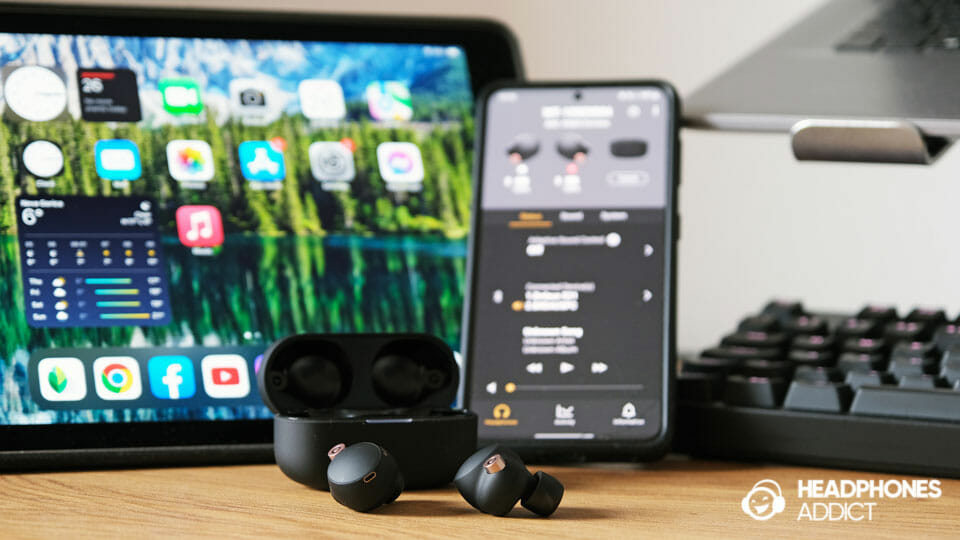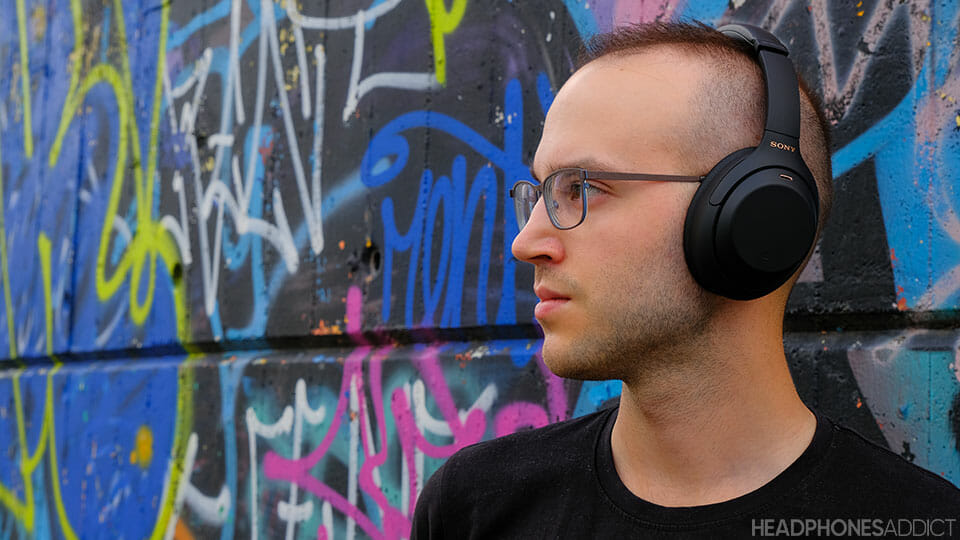Bluetooth multipoint removes the hassle of manually disconnecting and reconnecting your Bluetooth headphones from one device to another.
Learn how Bluetooth multipoint works, why you might want it, and the disadvantages of using it.

What is Bluetooth Multipoint?
Bluetooth multipoint is the ability to connect one audio playback device (headphones) to two or more audio sources (smartphone, laptop, tablet, etc.) simultaneously and automatically switch between them.
In practice, you can connect your Bluetooth headset (or an outdoor speaker) to your smartphone and laptop at the same time.
- Bluetooth multipoint was introduced in Bluetooth 4.0 in 2010, initially in its advanced form. More on that later.
To work, it requires Bluetooth profiles A2DP, HSP (headset profile), and HFP (hands-free profile). Depending on the profile, your headphones either support phone-PC or/and phone-phone configuration.
Despite multipoint technology being available for more than 10 years, only a few headphones support it.
Benefits of Using Bluetooth Multipoint
Multipoint can be a game-changer for businesspeople and multitaskers. However, like with many other features, not everyone finds Bluetooth multipoint useful.
Here are the benefits:
Easier to switch between devices
Using Bluetooth multipoint primarily benefits power users who regularly use headphones and a computer/tablet and receive many phone calls throughout the day.
The feature gives you the ability to use multipoint headphones with your PC yet still hear notifications and answer calls from your phone. All this happens automatically.

Increased productivity and convenience
As a result of automatic switching, the feature comes in handy during work hours when you don’t want to miss important calls while working on something else.
Or, when you end up watching videos on your laptop and decide to use your smartphone instead, the audio automatically shifts from laptop to smartphone.
Limitations of Bluetooth Multipoint
Bluetooth multipoint is a neat feature, but it only works in a specific way. Furthermore, it can sacrifice other important things like battery life, sound quality, and connection range.
Here are the most significant Bluetooth multipoint limitations.
Compatibility issues
First of all, a few Bluetooth headphones support multipoint. And some suffer from poor implementation.
Sometimes, you don’t hear notifications pushed through, or you experience a massive delay in receiving the notification.
It only works a specific way
Bluetooth multipoint only works by connecting an audio playback device (wireless headphone or speaker) to source devices (smartphone, computer, TV).
You can’t do it the other way. Connecting your phone to two headphones so that audio automatically switches headphones as soon as you change them.
While you can pair and play audio through 2 Bluetooth devices using Bluetooth 5.0, you have to make the switch manually.
Decreased battery life
Internet forum users claim that having your headphones connected to multiple devices simultaneously significantly impacts battery life.

The battery drain seems equally as severe as with active noise cancellation. That means that multipoint, while an old tech, isn’t energy efficient. Remember that when you enable it.
Limited range
Bluetooth antennas in headphones are usually much weaker than the ones inside your smartphone.
Now give them the responsibility to maintain the connection with two different devices, and the connection range gets shorter.
Worse audio quality (in some headphones)
For headphones to maintain the connection with two different devices, they might sacrifice the higher bandwidth required for high-quality audio codecs like LDAC.

As a result, some headphones automatically choose different Bluetooth codecs (from LDAC to AAC). On Android devices, using AAC can sometimes result in noticeably quieter audio playback.
Interestingly, Sony WF-1000XM4 still use LDAC even with multipoint enabled, whereas Sony WH-1000XM4 don’t.
Why many modern wireless headphones don’t have multipoint?
Many modern wireless headphones don’t have a multipoint pairing feature because it doesn’t make financial sense for manufacturers to include it.
It requires extra work to make it right (buggy multipoint is annoying rather than helpful), and it doesn’t seem important to regular users. Even though it is a huge selling point for the Apple ecosystem.
How to Pair with Bluetooth Multipoint?
Firstly, your headphones or speaker need to support the feature. Secondly, using multipoint mode works in 2 ways. For example:
To enable multipoint for Sony WF-1000XM4:
- First, you must pair your headphones with the Sony Headphones app.
- Inside the companion app, go under the “System” tab and enable “Connect to 2 devices simultaneously”. Note that the toggle could resist a little, so press it multiple times and enable Wi-Fi to see if that helps.

- After the earbuds restart and reconnect to your smartphone, go under the “Status” tab to see Connected Devices. You can see all Bluetooth devices that you once connected with your Sonys.

- Now you can turn on Bluetooth on your tablet or laptop (that you have previously used and remembered your Sony’s), and its name should appear in your app next to your phone’s name. If your tablet or laptop doesn’t remember your headphones, you have to put them in pairing mode and pair them to the new device first.

Sony’s approach is slightly more elegant, as it lets you select which device you want to connect to. On the other hand, JBL outdoor speakers and 1MORE headphones (like 1MORE Aero) use a more “random” approach.
To use JBL Flip 6 in multipoint connection:
- First, connect it to one device.
- Then turn on Bluetooth on the second device (that has been previously connected and remembers your JBL) and wait for it to pair to your JBL.
Now the speaker is connected to 2 devices
Let’s talk about the different priority modes between Sony and JBL. For example:
- JBL speaker will play audio from whichever device you press “play”.
- Sony will only play audio from the other device if you first pause it in device A and resume it in B.
What devices support Bluetooth multipoint?
Devices that have Bluetooth multipoint support are typically headphones and speakers with Bluetooth 4.0 or newer. Devices that you can pair them to are limited to the appropriate Bluetooth profiles.
If your headphones have a newer Bluetooth version but don’t support the appropriate Bluetooth profiles, multipoint won’t work.
Possible configurations range from headphones connected to a:
- Smartphone-smartphone
- Tablet-smartphone
- Laptop-smartphone
- TV-smartphone
- Tablet-laptop
Don’t confuse multipoint with Bluetooth 5.0’s ability to send audio to 2 headphones simultaneously.
How Bluetooth Multipoint Works?
Bluetooth multipoint works by an audio playback device establishing a simultaneous connection with two or more audio source devices.

The purpose of this feature is for an audio playback device to automatically switch between audio source A and B depending on the importance of the source signal.
Bluetooth multipoint uses the same hierarchy as your smartphone to determine what is the most and the least important:
- Phone and video calls are the most important, overriding other audio signals.
- Smart assistants and system sounds like alarms or notifications hold 2nd place.
- Watching videos or listening to music is at the bottom.
What that means is that if you watch a video on a connected laptop and receive a call on a connected phone, it will override the video since the call is more important.
To do that, your audio playback device (headphones, speaker) has to support the feature. As mentioned above, not all modern Bluetooth headphones have it.
Simple multipoint vs. advanced multipoint
The difference between simple and advanced multipoint is that the latter can place phone calls on hold.
Bluetooth multipoint was first introduced for businesspeople that receive phone calls from different devices.
- Advanced multipoint enables them to answer a call during a call and automatically put the previous one on hold. Furthermore, it lets you connect to more than 2 devices, which comes in handy in call centers.

For some reason, multipoint later got simplified for consumer headphones.
- Simple multipoint automatically ends/drops a previous call if you answer a new one, and it can only connect to 2 devices.
There is a version of simple multipoint with support for connecting up to 3 devices (triple connectivity), but it’s rare.
How does Apple and Samsung multipoint work?
Bluetooth multipoint described above works by selecting two different devices and then enjoying the benefits of multipoint connectivity.
On the other hand, Apple’s and Samsung’s approach is slightly different. Both companies made an ecosystem where all of their Samsung Galaxy Buds and Apple AirPods work seamlessly with each other without you selecting them.
What you need to do is to:
- Ensure you have headphones and at least 2 audio source devices from Apple/Samsung and that all 3 devices are signed into the same Apple/Samsung online account.
- Pair your Apple/Samsung headphones with one of those devices.
- All devices that use that online account should now seamlessly connect with your headphones.
As long as you stay signed into the account, you should enjoy the benefits of multipoint.
The pros of this approach are that you can stay paired to as many devices as you want. On the flip side, the con is that your Apple/Samsung headphones only support multipoint inside their branded ecosystem.
Frequently Asked Questions (FAQ)
What is Bluetooth multipoint?
Bluetooth multipoint is the ability to connect your Bluetooth headphones/speaker to 2 or more devices simultaneously and automatically transition between them.
How important is Bluetooth multipoint?
Bluetooth multipoint is primarily important for multitaskers that use headphones on different devices and businesspeople who want to receive all calls and notifications while working on multiple devices.
Can you connect 3 devices at once?
You can connect 3 devices at once if your audio playback device supports Bluetooth multipoint with a triple connection. However, the majority of consumer gadgets can connect up to two devices.
What apps can I use to connect 2 Bluetooth devices at once?
Headphones/speakers that support Bluetooth multipoint come with their own apps, or you can simply connect 2 Bluetooth devices to them. On the flip side, Bluetooth 5.0 already lets you send audio to 2 headphones/speakers simultaneously.
What Bluetooth devices support multipoint?
Bluetooth devices that typically support multipoint are headphones, earbuds, and speakers. However, ensure that they actually support it since many modern models don’t have it.
Does Bluetooth 5.0 have multipoint?
Bluetooth 5.0 introduced the ability to connect and send audio to 2 audio devices like headphones or speakers. It differs from Bluetooth multipoint, which connects a single audio device to 2 source devices (phone, laptop, etc.).
Conclusion
Bluetooth multipoint doesn’t benefit everyone. But it’s a godsend for power users.
The main benefits are ease of use since devices switch audio automatically based on priority, which can also increase productivity.
On the other hand, multipoint sips battery life quicker limits the connection range, and can also worsen the audio quality.

From a childhood fascination with sound, Peter’s passion has evolved into a relentless pursuit of the finest headphones. He’s an audio expert with over 5 years of experience in testing both audiophile and consumer-grade headphones. Quote: “After many years, I can confidently tell which headphones are good and which are terrible.” Find his honest opinion in his reviews.



